This may come as a surprise to some, but not everyone loves salt chlorine generators. Each pool owner has their reasons for not liking salt pools. Some people experience rusting, others have softstone decks, or just don’t like plunking down a few hundred dollars for a replacement cell. No matter what the reason is, these pool owners want the easiest way of converting their pool from saltwater to traditional chlorine, a.k.a. freshwater.
In this article, we will discuss the water chemistry and hardware hurdles to overcome when making the switch. But the question asked most often is the following:
Do I have to drain my pool?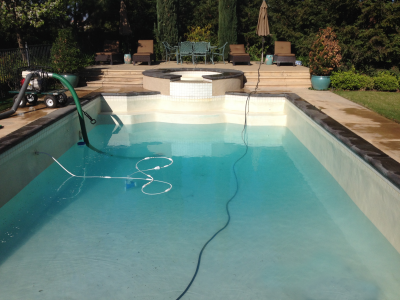
Not entirely, but you will be draining a portion of your pool’s water that will be replaced with fresh water to lower the cyanuric acid (CYA) levels. The chemical CYA is sometimes referred to as stabilizer. Chlorine created by salt generators is a pure form, meaning salt pools require of you to add CYA to protect the chlorine. A salt pool’s CYA levels hover around 80-90 parts per million (ppm), whereas chlorine pools should be about half that at 40 ppm.
CYA, unlike chlorine, does not dissipate from pool water. So, to lower your CYA, you must drain a portion of your pool and then refill with fresh water. A good method of draining is the percentage method. If your CYA level is 80 ppm and you want it at 40 ppm, drain about 50 percent of your water.
For you folks in areas with high water tables, like us Floridians, be mindful of when you drain the pool. Do not drain your pool in the rainy season or after periods of heavy rain, or you may pop your pool.
Balancer Chemicals for Traditional Chlorine
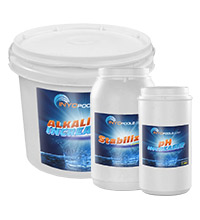
You will essentially be continuing your regiment of testing pH, alkalinity, and hardness, applying pool chemicals as needed. You can probably chuck your bottles of CYA, because tablets and liquid chlorine contain stabilizer within their formulas.
For a guide on pool chemistry, follow this link: How To Maintain A Swimming Pool Part 1 (Chemicals).

Will residual salt affect my pool?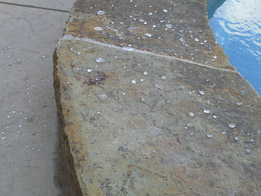
No, the leftover salt in your pool water does not pose a danger to your pool equipment. The electrolysis created by the reaction to the salt cell is what caused most of the corrosion in your pool, not the salt itself. Without the cell, the salt will be relatively harmless.
And before you fire up the keyboards talking about the corrosiveness of seawater, be aware that seawater contains 35,000 ppm salinity level, and your pool water has about 3,500 ppm tops. After you have purged so much water to lower your CYA, your pool water’s salinity level will be a fraction of the 3,500 ppm.
Picking a Chlorinator
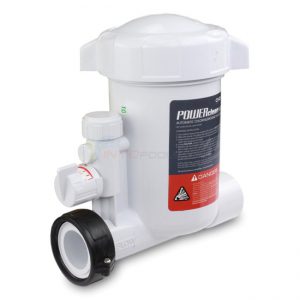
We cover the pros and cons of various types of chlorinators in the video above. I have it cued to the section explaining the differences between the three main choices which are floating, in-line, and off-line chlorinators.
For the in-line and off-line types, the biggest concern will be location and spacing. Chlorinators should be the last piece of equipment on your plumbing line, after your filter, gas heater or solar panels. So, you will need to find a spot with straight pipe that is long enough and with enough clearance above and below to install and service the chlorinator.
Regular flow-through salt cells like the Intellichlor, AquaRite, and Pureline are long enough for an in-line chlorinator to be slotted in its place. If your equipment pad is a tight squeeze or your cell has an odd configuration like a CompuPool or Jandy AquaPure Ei, an off-line chlorinator will be the better choice. It requires a small hole to tap the plumbing line and for the return feeder line. And it can be set beside the equipment pad instead of on the pipe.
Removing and installing equipment
Removing the old salt system is pretty simple and most would follow these three steps:
- Shut off the power to the control box, then unmount it.
- Remove the flow switch from the tee mount, plug the tee tap or remove the tee and replumb the section.
- Unscrew the cell from the plumbing line.
If you have one of those flow through cells like the Hayward AquaRite, then those steps are simple. But if you have a CompuPool upside down U-shape or the AutoPilot manifold design, the removal of the cell and associated piping will likely require some PVC elbow grease.

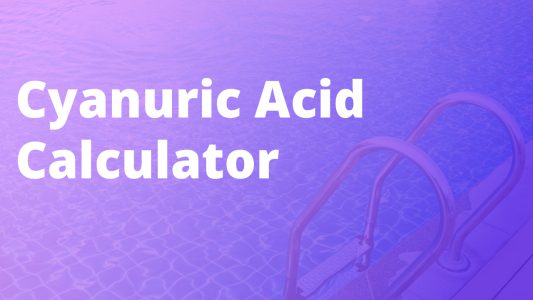
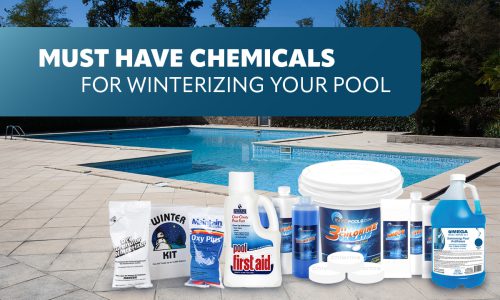
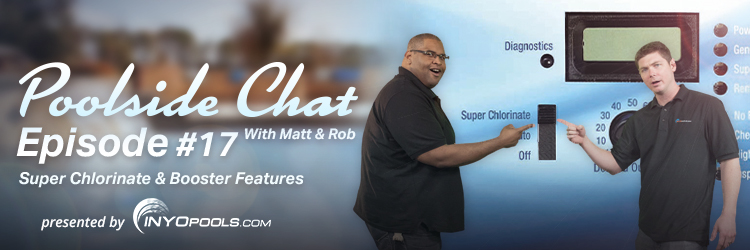
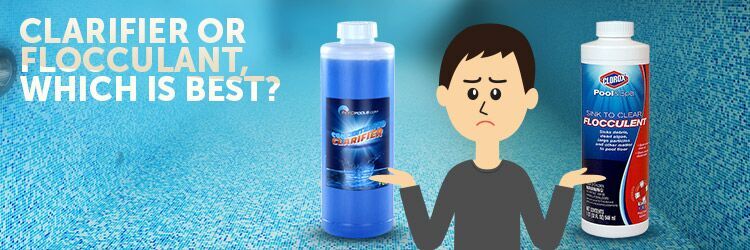






Could you just put an inline chlorinator where the salt cell was at? Do they make one that will fit where Pentair IC40 is inline?
Yeah, an inline chlorinator can be slotted in place of the salt cell. However, no chlorinator has the same dimensions as the IC40 cell without supplementing it with other PVC parts. You could also install an offline chlorinator and use a short piece of PVC to bridge the cell gap. The new PVC could also be the offline chlorinator’s tapping point, so you don’t have to modify your old PVC.
I don’t like having to keep the solar cover off for 24 hours (and lose they heat) while regenerating with the salt water pool. The 3 step chlorine process was so much easier.
I was told that because we removed the salt cell years ago that it caused my heater to malfunction. FYI my heater is 12 years old and is now leaking.
How many years ago did you remove the salt system? If the heater is 12 years old and you just removed the salt system 2 or 3 years ago there could be some residual damage from the decade of salt water going through it. But that wouldn’t be out of the ordinary.
A pool heater usually lasts around 10 years anyway. If you are just now experiencing heat exchanger issues, then I would consider yourself semi-lucky. I say semi because you still need to get it repaired or replaced which equals a lot of moolah.
About a year ago I switched my indoor pool from salt to chlorine because it was pitting my stainless steel sides (I have stainless sides and a glass tile bottom), and, it was destroying my limestone coping.
I now get a light film on the surface of the water everytime I open and close the vinyl pool cover. It eventually dissipates but reappears when I close then open the pool cover. it is a fine film that dissipates with a drop of dawn dish soap, but never goes away. It also shows little white flakes on the surface sometimes as well.
When I switched I drained the pool for cleaning and repair and added new water. Then filled and the problem started. I drained the pool again, scrubbed the underside of the pool cover twice, changed chlorine tabs, refilled the the problem re-occured a week later. Since then I’ve replaced the filters, installed a new pool cover (thinking the plasticizers were leaching out, and even had an HVAC company check the dehumidification system that uses the pool water to evac heat (and it tested perfect) thinkin that coolant was escaping into pool . My pool chemistry is good and I’ve had it double checked by Leslie Pool.
Any ideas? thank you in advance.
Hi Matthew, I purchased a home in Costa Rica and we are having a fiberglass pool installed. We are being asked if we would like to have a chlorine or salt water pool with standard pump or variable speed pump. The climate is warm all year and the pump will be running all year round. In this scenario would you still recommend a salt water pool over a chlorine pool? We are planning to rent it out occasionally as well if that makes a difference and the additional costs for a salt water pool is $800US and the variable speed pump is also $800US extra.
Pool size is 271 square feet and 4.6 feet deep.
Any thoughts?
15 years of salt pool when initially built and tired of all the issues mentioned above, switched to tabs. Salt pool require so much extra work. Not just salt cell replacement. Cords need replacing regularly, PH is biggest issue causing scaling and muriatic acid addition each day, flow issues, trouble codes and lights and trying to figure out why chlorine isn’t being generated on any given day, trying to get the % correct, not noticing generator not making chlorine for any number of reasons, salt causing corrosion on stamped concrete and other salt issues in landscape, list goes on forever. Forget the extra cost each week and claims it is cheaper in long run, it is not. The time and frustration of keeping a salt system working correctly is my biggest pool chore by far. Salt pools are way way over hyped, little to no advantage compared to the extra work and problems it introduces.
I agree I moved to Florida and I have a saltwater pool now I had a chlorine pool in Corpus Christi and it was a lot simpler I was gonna wait till the generator quit working but I’m thinking about just going to Chlorine right now getting it done
John what you said is so true I have a salt pool an it has worked me to death an always buying something to put in it I want to go back to chlorine but not sure how.
Hi Erica. My question/issue is the same as yours & I like this blog but haven’t seen Matthew answering lately. I’m hoping this prompts a new question that needs attention.
I have a great “looking” setup behind the scenes but going to chlorine is definitely for me (from previous experience). My pool is FINALLY algae free, clear blie & I can visually tell if it needs backwashing, ez. The man at my pool store (large chain, I think he’s well experienced) told me that all I had to do was turn off/unplug the salt cell, keep chlorine tabs floating & shock it 1x/wk. I had to shock more, backwash more, add water more at beginning but now again it’s just a visual thing. BUT.. it’s also chilly weather with not much rain so I’m sure that’s affecting things. Oh Salt on control box (which is for lights, everything) says ck salt level 0000 ppm. Sounds good to me. MY CONCERN – is the plugged in salt cell doing any harm (like do the plates inside it cause issues with the water?). ALSO, I am now but will stop, running pump 24/7 til water cleared up. Just forgot to set timer.
Matthew???
The cell’s plates may accumulate some scale which you would want to monitor. Generally, if you are switching back to chlorine the cell is removed pretty soon thereafter, so I am not wholly sure of the longterm effects of keeping it in place.
We bought our home with a salt generator installed and the next season I issues with the flow switch several times and now the circuit board. The pool tech who came out to give us an estimate said we could just switch over to chlorine without changing anything. Since my system isn’t actually working, do I still need to plug anything off or remove my salt cell? I have a vinyl lined inground pool approx 15,000 gal. Also, we have a floating chlorinator that was recommended to us by our local pool store but we had trouble keeping the chlorine level adequate this year. Any suggestions on why? Chemistry was in check otherwise.
I should add that this summer we did not fix the SWG and just used the chlorine floater and weekly shock with the setup unchanged.
Erica, if you read the article above it pretty much tells you everything asked in your question.
Thank for your reply. I did read the article above. I’m wondering if the 3 steps mentioned are required to do, or if that’s if you want to remove the SWG for aesthetic reasons. For example, as long as the power is off, I wouldnt need to unmount the control box (this would probably look worse, since the siding behind it is likely darker being protected from the elements). But how about plugging the switch? And removing the cell would add cost because I’d have to get a dummy in its place as you suggested to someone who asked. But would it hurt to just leave it connected? Is it doing anything if the power to the box is off?
I have a saltwater pool and it destroying my coping and moss rock, which the builder never said anything to us about salt and natural rock. They guy at the pool store told me to pull my salt cell off and put a cell pipe/ winterizing cap as a replacement and use chlorine tablets. I have a jandy aquapure Ei series apure 35. My question is what do I do with the cell leads once I take off the cell? Any information will be helpful
Hello – what are you describing when you say “cell leads”? If you are referring to the holes in the pipe, you can plug them or cut out that portion of pipe then fill the gap with a fresh piece with unions. If you are referring to the actual electrical leads of the salt cell, you can do whatever you like with them if you don’t plan on reinstalling the cell.
I agree with you. My salt system is 4 years old. It started becoming mentally irregular after year 2. I am tired of trying this, cleaning that, checking contacts, etc. The answer is in the one paragraph that says the chlorinator is good for about 8,000 hours (about 3 years in Florida). I do not intend on doing anything except permanently turn off the power supply box and check my water chemistry the old fashioned way. If I sell my house someday, and they ask what kind of pool I have I will say salt water. It still is a salt pool. I just choose to operate my own way.
Awesome can’t wait to ditch this salt system, I gave it a fair go at two years. Time to go back to the tabs and stop stressing this salt system. This answered my question, no need to worry about the salted water. Thanks.
I have a salt pool that is 3 yo. I just replaced the cell now the power source is gone. The cost to replace is just under the cost of a completely new system. Ridiculous! I found a place in Australia that sells the cells at half of what they cost here with free shipping and zero tax. Takes 8 weeks though to get them. Going back to chlorine!
By the way – you guys are the best on line pool site.
Helpful reads. I initially liked our salt conversion after resurfacing, but I am considering going back to tablets, am torn. As one person above states, I’ve been struggling, albeit intermittently, with with my salt pool. One thing, not mentioned above, is that with a salt pool, things are a little bit more “out of sight”. Unless you check your pool EVERY SINGLE DAY, things might start to slip. I have had the cell begin to reduce or stop salt production altogether — and didn’t recognize the slippage until too late…argh. Control reset issues: control says “check cell; low salt level” — but the salt level ok – verified. My control will not reset, per the instructions provided on your site. Cell taken in and tested? Tested good. Too many variables to troubleshoot. I’m almost ready to go back to tablets lol.
I have an intellchlor I20 and wantbot go back to chlorine. Is there any way to remove the plates from the cell leaving just the body, so I dont have to change the plumbing
Thanks
Sy
they sell a dummy cell that would take the place of the ic 20 unit
I agree with you Tom. I have had a Salt pool for over 13 years and it has been a headache. I have spent lots of money on Salt Cells over the years. I feel like the technology isn’t quite up to par just yet. A good example is the price you pay for the Salt Cell and the warranty that comes with it. Plus, what you save in chlorine tablets you spend in electricity (especially in the summer) to keep chlorine levels up. Even with conditioner the pump must run to create chlorine to make to the end of a sunny day. The salt system is easy on the eyes but with proper chemical monitoring I feel I can get the same benefits from normal chlorine. Chlorine Tablets here I come.
Every pool is different, so there are some outliers, but the vast majority of pool owners we deal with on a daily basis prefer their salt over chlorine. I can’t speak too much on why your particular pool was difficulty with the switch, but the root could be a sizing issue. If a 20K gallon cell is put on an 18k gallon pool, you will need to run the salt system nearly full strength to properly chlorinate the pool. That kind of installation can kill a cell quickly.
Regarding your pump run time point, I think that is inaccurate. If you use liquid chlorine, the pump still has to run to mix it into solution properly. If you are using tablets, then you are still using the pump to push the water through the inline or offline chlorinator. Whichever route you take, traditional or salt, the pump is going to be used. Salt does not require more of the pump if you have the system installed and set up correctly for your pool’s needs.
We put the required salt in our pool but our saltwater pump never worked to change it to the salt. Now we have a pool full of salt. How do I remove the salt to go back to regular chlorine? Thanks.
*To change the salt
Other than draining the pool and starting with fresh water, there is no way to remove the salt. But you can just start adding chlorine to the pool. The salt will not affect the chlorine liquid or tabs used.
When I decided to go back to chlorine tablets, I just unplugged the salt cell. Is that a mistake? What’s going to happen to the salt that’s still in the pool? Should I be concerned? I really don’t want to have to drain!
I’m new to this & worried. Please help!!!
Scale could form on the cell causing a lot of backpressure and a blockage. As I cover in the article, the salt stays in the water. The salt level will eventually lower as you backwash or drain and refill with freshwater.
What if the 14 year old above ground pool was just opened and it tested at zero salt when we brought in the sample after bringing up the water level to a full pool. Can I simply start using chlorine tablets without having to empty any water? We’re already cleaning and back washing.
What plugs are needed to fill the 2 holes if I remove the saddle clamp on my pvc pipe? I removed my AquaPure Ei 35 Apure35 system except for the Jandy Saddle Clamp (R0511700) & Winterizing Cap (R0512700).
The AquaPure Ei 35 uses the port plug set, part number R0511800
I’m in the process of doing this very thing. I have fought with my pool’s chemistry for years and its constant pH drift and the resulting scale formation. No more! Whoever says a salt water pool is easier to take care of is either not well informed or is conning you.
Well, I can understand frustration coming from your particular situation. But most of the thousands of pool owners we’ve talked to over the years would say salt systems are the real deal.
Salt pools have a naturally higher pH, but if you are having constant pH rise issues it is a sign you are running your salt system too much without properly addressing your TA.
For learners who are new to the lingo and caught between conventional chlorine / acid pools and salt chlorine generator systems, acronyms are where learners check out and stop learning out of frustration. Using an acronym like TA without initially spelling it out assumes we are as expert as the experts answering the questions. One way around this is to provide a comprehensive list of all acronyms and their meanings for the learners, then pause while some refer to the list to define the meaning, until the list has been learned by all. Don’t fall into the trap of using these abbreviations to distinguish the teacher from the student, the students will never rise to the goal the teacher is striving for.
By the way, I assume you mean Total Alkalinity, but I am guessing.
By no means was I using jargon to separate me from our readers. Total Alkalinity (TA) is a very common term used in this blog, especially by me. And although there are lots of beginners that find us, there are also curious experienced pool owners who have the basics down. So when I’m firing off a quick reply to someone, and I don’t want to type Total Alkalinity for the 20th time of the day, I’ll use the abbreviation because it is quicker. Especially if I can gauge by the question if the commenter is more experienced.
On the flipside, if this was a formal article, I would follow the standard procedure of laying it out with the abbreviation. But seeing as this was a simple reply to a question focused purely on water chemstry, i think even a pool newcomer could narrow TA down to meaning Total Alkalinity.
Also, if someone is curious about a term, they can always simply ask. I’m here to help.
Tom, I just say your post over a year ago, and I couldn’t agree with you more. I own and operate a Bed and Breakfast Inn and have tried to do salt water pools TWICE now against the advise of the local Health Department. They don’t like them primarily because of the CONSTANT battle with high PH which makes the chlorine very ineffective. The problem of keeping the PH down under a salt water system is never ending no matter how well you control your Alkalinity. I have to add at least 16 oz of Muriatic acid EVERY day because the chlorinator process constantly pushes the PH up. It never ends. And then to make matters even more complicated the Muriatic acid also lowers the Alkalinity which makes the PH bounce even more if I ever do get it lowered. And then when I raise the Alkalinity with bicarbonate of soda, the PH sneaks right back up. It has been a never ending “catch 22” problem every day. Upon the advice of the county health department I am in the process of turning my salt water pool BACK to a regular pool for the second time for all these reasons. I think most people that have installed residential pools as saltwater are probably not even aware what a problem this is because they are told that a saltwater pool is maintenance free and less expensive to operate. In my experience nothing could be further from the truth. In fact, I would be willing to bet that most residential salt water pools have PH off the charts with limited chlorination effectiveness unless the homeowner is checking PH EVERY SINGLE DAY and adding gallons and gallons of muriatic acid . In the end one is making chlorine out of the salt, so why not just use chlorine to begin with and skip all the headaches. (Oh, I almost forgot….the salt keeps rusting out my light fixture)
Agreed. My parents owned a chlorine pool. When I bought my current house it came with an almost new pentair chlorinator and the whole bit. It’s unplugged and I pour in liquid chlorine and shock when I need to. Keep and eye on ph and I’m good to go. I made the decision after carrying numerous bags of salt to my back yard F that.
idiot.
Hello Mr. Simmons: do you have any info on converting from a chlorine system to a salt system? Would be great to see if it would be advantageous to me. Could you also send me some info on the equipment we will need to make the conversion. Thanks
We have just the article for you: Converting Your Pool to Saltwater
I believe there are links to equipment in the article.
I’m looking at a house in Florida and we both love it but it has a saltwater pool would it cost me a lot to convert to chlorinated water
Not if you follow the steps mentioned in the article. Outside of the cost of chlorine tabs or liquid, the cost to convert is relatively nothing.